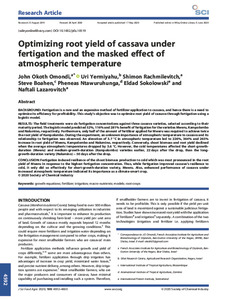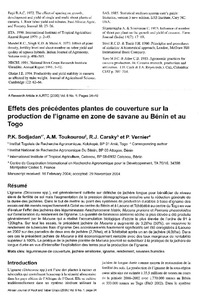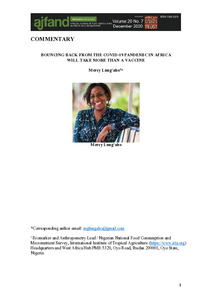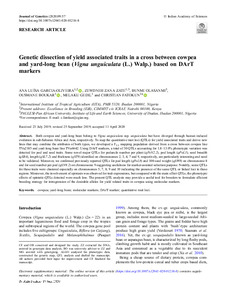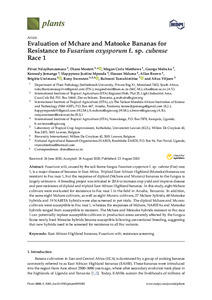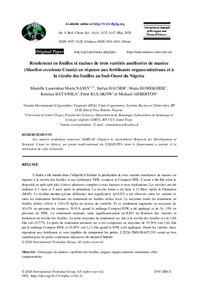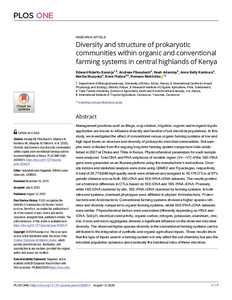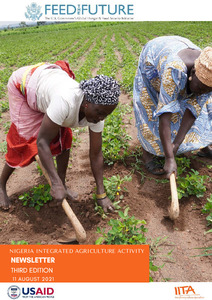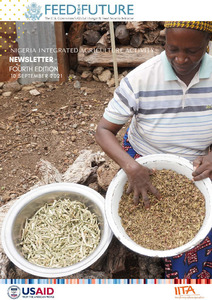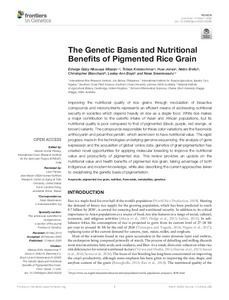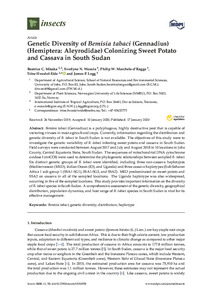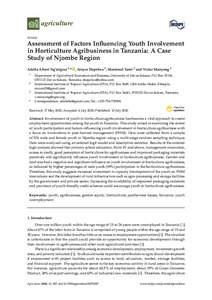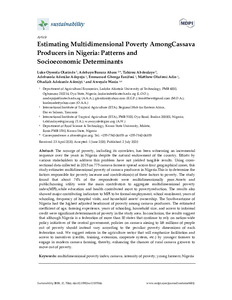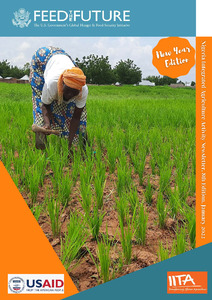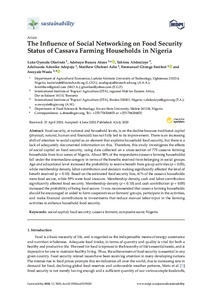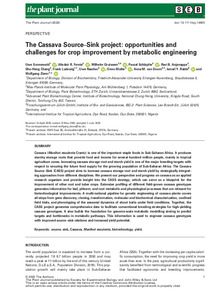Welcome to the International Institute of Tropical Agriculture Research Repository
IITA Bibliography System: Recent submissions
Now showing items 961-980 of 8102
-
Optimizing root yield of cassava under fertigation and the masked effect of atmospheric temperature
(2020-09)BACKGROUND Fertigation is a rare and an expensive method of fertilizer application to cassava, and hence there is a need to optimize its efficiency for profitability. This study's objective was to optimize root yield of cassava through fertigation using a logistic model. RESULTS The field treatments were six fertigation concentrations against three cassava varieties, selected according to their maturity period. The logistic model predicted 52%, 116% and 281% benefit of fertigation for the varieties ... -
Effets des precedentes plantes de couverture sur la production de l'igname en zone de savane au Benin et au Togo
(2005)L'igname (Dioscorea spp.), est généralement cultivée sur défriche de jachère longue pour bénéficier du niveau élevé de fertilité de sol mais l'augmentation de la pression démographique entraîne une la réduction générale de la durée des jachères. Dans le but de mettre au point des systèmes de production durables à base d'igname des essais ont été menés respectivement à Gobé au centre du Bénin et à Laouno et Tchébébé au centre du Togo en vue d'évaluer l'effet des jachères des légumineuses Aeschynomene ... -
Genome-wide association analyses reveal the genetic basis of biomass accumulation under symbiotic nitrogen fixation in African soybean
(2020-02)Symbiotic nitrogen fixation (SNF) increases sustainability by supplying biological nitrogen for crops to enhance yields without damaging the ecosystem. A better understanding of this complex biological process is critical for addressing the triple challenges of food security, environmental degradation, and climate change. Soybean plants, the most important legume worldwide, can form a mutualistic interaction with specialized soil bacteria, bradyrhizobia, to fix atmospheric nitrogen. Here we report ... -
Genetic dissection of yield associated traits in a cross between cowpea and yard-long bean (Vigna unguiculata (L.) Walp.) based on DArT markers
(2020-06-19)Both cowpea and yard-long bean belong to Vigna unguiculata ssp. unguiculata but have diverged through human induced evolution in sub-Saharan Africa and Asia, respectively. To map the quantitative trait loci (QTLs) for yield associated traits and derive new lines that may combine the attributes of both types, we developed a F2:3 mapping population derived from a cross between cowpea line TVu2185 and yard-long bean line TVu6642. Using DArT markers, a total of 30 QTLs accounting for 1.8–13.0% phenotypic ... -
Evaluation of Mchare and Matooke Bananas for Resistance to Fusarium oxysporum f. sp. cubense Race 1
(2020-09)Fusarium wilt, caused by the soil-borne fungus Fusarium oxysporum f. sp. cubense (Foc) race 1, is a major disease of bananas in East Africa. Triploid East African Highland (Matooke) bananas are resistant to Foc race 1, but the response of diploid (Mchare and Muraru) bananas to the fungus is largely unknown. A breeding project was initiated in 2014 to increase crop yield and improve disease and pest resistance of diploid and triploid East African Highland bananas. In this study, eight Mchare cultivars ... -
Rendement en feuilles et racines de trois variétés améliorées de manioc (Manihot esculenta Crantz) en réponse aux fertilisants organo-minéraux et à la récolte des feuilles au Sud-Ouest du Nigeria
(2020-05)L’étude a été menée dans l’objectif d’évaluer la production de trois variétés améliorées de manioc en réponse à la récolte des feuilles et aux fertilisants NPK, compost et Compost-NPK. L’essai a été fait selon le dispositif en split-split plot, à blocs aléatoires complets à trois facteurs et trois réplications. Les récoltes ont été réalisées à 3 mois et 5 mois après la plantation. La récolte finale a été faite à 12 Mois Après la Plantation (MAP). Le résultat montre qu’une différence non significative ... -
Diversity and structure of prokaryotic communities within organic and conventional farming systems in central highlands of Kenya
(2020)Management practices such as tillage, crop rotation, irrigation, organic and inorganic inputs application are known to influence diversity and function of soil microbial populations. In this study, we investigated the effect of conventional versus organic farming systems at low and high input levels on structure and diversity of prokaryotic microbial communities. Soil samples were collected from the ongoing long-term farming system comparison trials established in 2007 at Chuka and Thika in Kenya. ... -
Feed the Future: Nigeria Integrated Agriculture Activity
(United States Government, 2021-08-11) -
Feed the Future: Nigeria Integrated Agriculture Activity
(United States Government, 2021-09-10) -
Integrated health interventions for improved livelihoods: a case study in Ethiopia
(2020)Smallholder farmers in sub-Saharan Africa (SSA) face multifaceted and co-existing risks, such as human and animal diseases and pests. Even though smallholder farmers often experience these challenges simultaneously, interventions to address these challenges are often implemented in a piecemeal fashion. However, managing agricultural production constraints without alleviating human and livestock health burdens might not generate significant and sustained benefits to achieve the desired development ... -
The genetic basis and nutritional benefits of pigmented rice grain
(2020-03-13)Improving the nutritional quality of rice grains through modulation of bioactive compounds and micronutrients represents an efficient means of addressing nutritional security in societies which depend heavily on rice as a staple food. White rice makes a major contribution to the calorific intake of Asian and African populations, but its nutritional quality is poor compared to that of pigmented (black, purple, red orange, or brown) variants. The compounds responsible for these color variations are ... -
Genetic diversity of Bemisia tabaci (Gennadius) (Hemiptera: Aleyrodidae) colonizing sweet potato and cassava in South Sudan
(2020)Bemisia tabaci (Gennadius) is a polyphagous, highly destructive pest that is capable of vectoring viruses in most agricultural crops. Currently, information regarding the distribution and genetic diversity of B. tabaci in South Sudan is not available. The objectives of this study were to investigate the genetic variability of B. tabaci infesting sweet potato and cassava in South Sudan. Field surveys were conducted between August 2017 and July and August 2018 in 10 locations in Juba County, Central ... -
Assessment of factors influencing youth involvement in horticulture agribusiness in Tanzania: a case study of Njombe region
(2020)Involvement of youth in horticulture agribusiness has become a vital approach to create employment opportunities among the youth in Tanzania. This study aimed at examining the extent of youth participation and factors influencing youth involvement in horticulture agribusiness with a focus on innovations in post-harvest management (PHM). Data were collected from a sample of 576 male and female youth in Njombe region using a multi-stage random sampling technique. Data were analyzed using an ordered ... -
Estimating multidimensional poverty AmongCassava producers in Nigeria: patterns and socioeconomic determinants
(2020)The scourge of poverty, including its correlates, has been witnessing an incremental sequence over the years in Nigeria despite the natural endowment of the country. Efforts by various stakeholders to address this problem have not yielded tangible results. Using cross-sectional data collected in 2015 on 775 cassava farmers spread across four geographical zones, this study estimates multidimensional poverty of cassava producers in Nigeria. This is to determine the factors responsible for poverty ... -
Feed the Future: Nigeria Integrated Agriculture Activity
(United States Government, 2021-12) -
Feed the Future: Nigeria Integrated Agriculture Activity
(United States Government, 2022-01) -
The influence of social networking on food security status of cassava farming households in Nigeria
(2020-07-04)Abstract: Food security, at national and household levels, is on the decline because traditional capital (physical, natural, human and financial) has not fully led to its improvement. There is an increasing shift of attention to social capital as an element that explains household food security, but there is a lack of adequately documented information on this. Therefore, this study investigates the effects of social capital on food security, using data collected on a cross-section of 775 cassava ... -
The Cassava Source-Sink project: opportunities and challenges for crop improvement by metabolic engineering
(2020-08)Cassava (Manihot esculenta Crantz) is one of the important staple foods in Sub‐Saharan Africa. It produces starchy storage roots that provide food and income for several hundred million people, mainly in tropical agriculture zones. Increasing cassava storage root and starch yield is one of the major breeding targets with respect to securing the future food supply for the growing population of Sub‐Saharan Africa. The Cassava Source–Sink (CASS) project aims to increase cassava storage root and starch ... -
Gliricidia agroforestry technology adoption potential in selected dryland areas of Dodoma region, Tanzania
(2020-07-20)Declining soil fertility is one of the major problems facing producers of field crops in most dryland areas of Sub-Saharan Africa. In response to the declining soil fertility, extensive participatory research has been undertaken by the World Agroforestry (ICRAF) and smallholder farmers in Dodoma region, Tanzania. The research has, amongst others, led to the development of Gliricidia agroforestry technology. The positive impact of Gliricidia intercropping on crop yields has been established. However, ...

